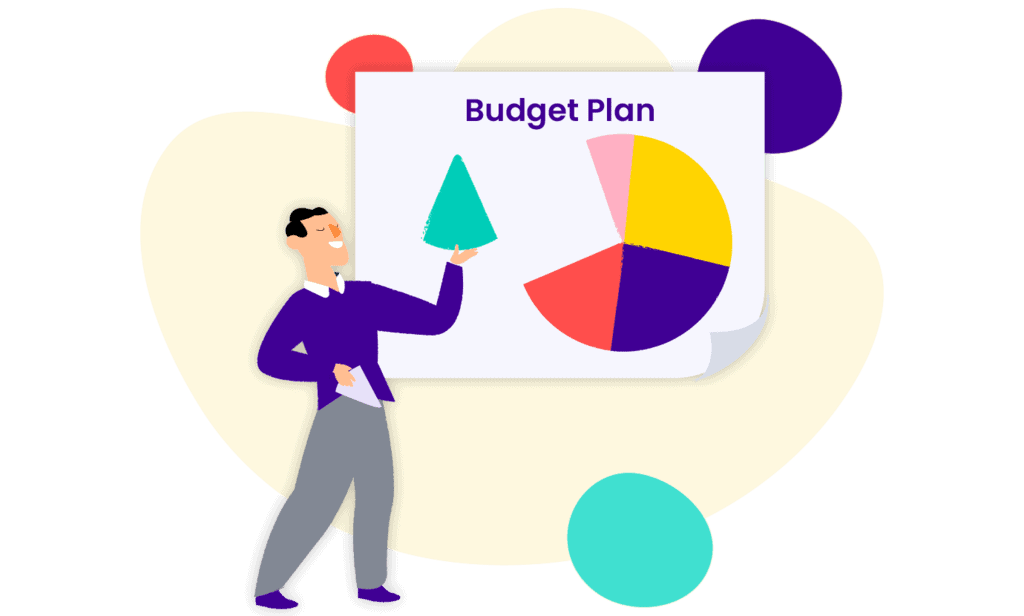A Marketing plan is a comprehensive document that outlines a company’s overall marketing strategy and the specific tactics and activities that will be used to achieve its marketing objectives. The plan provides a detailed roadmap for how the company will reach its target market, promote its products or services, and ultimately generate revenue.

Creating a marketing plan in 2024 follows many of the same principles as in previous years, but with advancements in technology, changes in consumer behavior, and evolving market trends, it’s important to stay up-to-date with the latest strategies and tools. Here are the steps to create a modern marketing plan:
Table of Contents
Step 1. Understand Your Audience
Understanding your audience is critical when creating a marketing plan. This involves more than just knowing demographic information. You must also understand your audience’s motivations, needs, challenges, and pain points. Here are steps to take:

- Conduct Market Research: Use both primary and secondary research to understand your audience. This can include surveys, interviews, focus groups, competitor analysis, and industry reports.
- Create Buyer Personas: Develop detailed profiles of your ideal customers. Include demographic information like age, gender, location, income, but also psychographic data like interests, values, preferences, and behavior patterns.
- Identify Customer Pain Points: What problems or challenges are your customers facing? How does your product or service help alleviate these issues? Understanding these pain points allows you to craft targeted messaging and solutions.
- Know Their Journey: Map out the customer journey from awareness to purchase. Understand the channels they use, the information they seek at each stage, and the factors influencing their decisions.
- Gather Data and Insights: Use analytics tools and customer relationship management (CRM) software to track customer behavior. Insights from website traffic, email open rates, social media engagement, and customer feedback can be invaluable.
- Listen and Engage: Social media and online communities can provide rich insights into your audience. Engage with them, ask for feedback, and participate in conversations to better understand their needs and preferences.
- Test and Iterate: Use A/B testing and other experimentation methods to refine your understanding of your audience. Continuously adapt your marketing strategies based on the feedback and insights you receive.
Step 2. Set Clear Objectives
Setting clear objectives is a critical step when creating a marketing plan. Objectives provide a clear roadmap and measurable goals for your marketing efforts. When setting objectives, it’s important to make sure they are SMART:
- Specific: Clearly define what you want to achieve. For example, rather than saying you want to “increase sales,” specify by how much and over what period.
- Measurable: Determine how you will measure success. This could be through specific metrics like sales revenue, website traffic, or leads generated.
- Achievable: Make sure your objectives are realistic and attainable given your resources and market conditions.
- Relevant: Ensure your objectives align with your overall business goals. For example, if your company’s goal is to expand into new markets, your marketing objectives should support this goal.
- Time-bound: Set a specific timeframe for achieving your objectives. This could be monthly, quarterly, or annually.

Examples of marketing objectives could include:
- Increase website traffic by 20% in the next quarter.
- Generate 100 new leads per month through content marketing.
- Increase brand awareness by 25% in the next six months.
- Achieve a 15% increase in sales conversion rates by the end of the year.
Once you have your objectives in place, make sure they are communicated clearly throughout your organization. Everyone involved in the marketing efforts should understand what they are working towards and how their efforts contribute to achieving the objectives. Regularly review and assess your progress towards these objectives, and adjust your strategies and tactics as needed to stay on track.
Step 3.Analyze the Market and Competition
Analyzing the market and competition is a vital step in creating a successful marketing plan. Here’s a guide on how to perform this analysis:

- Define Your Market: Start by defining the market or industry in which your company operates. This includes identifying the target market (the group of customers most likely to purchase your product or service) and the total available market (the overall market demand for your product or service).
- Gather Market Data: Collect data on market size, growth rate, trends, and customer behavior. You can use sources like industry reports, government statistics, and market research studies. Pay attention to macroeconomic factors that might affect your market, such as changes in consumer spending, technological advancements, or regulatory changes.
- Analyze Competitors: Identify your main competitors and analyze their strengths, weaknesses, opportunities, and threats (SWOT analysis). Examine their products, pricing, distribution channels, marketing strategies, and customer base. Look for gaps in the market that your company can exploit and areas where your competitors are vulnerable.
- Understand Your Competitive Advantage: Determine your company’s unique selling proposition (USP) or competitive advantage. This could be based on product quality, price, customer service, or other factors. Understand how your USP sets you apart from your competitors and use this as a basis for your marketing strategy.
- Identify Market Trends and Opportunities: Look for emerging trends in the market that could create opportunities for your company. This could include shifts in consumer preferences, technological advancements, changes in regulation, or new market segments.
- SWOT Analysis: Perform a SWOT analysis for your company. This involves identifying your company’s strengths, weaknesses, opportunities, and threats. Strengths and weaknesses are internal factors that you have control over, while opportunities and threats are external factors that you need to adapt to.
- Understand Consumer Behavior: Understand how your target market makes purchasing decisions. Consider factors like motivation, perception, attitudes, and decision-making processes.
- Identify Market Segments: Divide your target market into smaller segments based on common characteristics such as age, gender, income, lifestyle, and geographic location. This allows you to tailor your marketing efforts to each segment’s unique needs and preferences.
- Identify Key Insights: Based on your analysis, identify key insights about your market and competition. These insights will inform your marketing strategy and help you create a plan that is relevant and effective.

By conducting a thorough analysis of the market and competition, you’ll be better positioned to develop a marketing plan that is aligned with market trends, addresses customer needs, and outperforms your competition.
Step 4.Develop a Strategy
Developing a marketing strategy is essential for creating an effective marketing plan. Here are the key steps:
- Define Your Goals: Start by identifying the specific goals you want to achieve with your marketing efforts. These could be increasing sales, boosting brand awareness, improving customer retention, or launching a new product.
- Know Your Target Audience: Understand your audience’s demographics, psychographics, pain points, and buying behavior. Use this information to tailor your messaging, offers, and channels to reach them effectively.
- Position Your Brand: Define your unique value proposition (UVP) and positioning. What makes your brand stand out from the competition? Communicate this clearly and consistently in all your marketing efforts.
- Choose Your Marketing Channels: Select the marketing channels that are most effective for reaching your target audience. This could include social media, email marketing, content marketing, paid advertising, SEO, and more.
- Create Compelling Content: Develop content that provides value to your audience. This could be blog posts, videos, infographics, podcasts, or other formats. Focus on addressing your audience’s pain points, answering their questions, and showcasing your brand’s expertise.
- Optimize for Search Engines: Implement search engine optimization (SEO) strategies to improve your website’s visibility in search engine results. This involves optimizing your website’s content, keywords, meta tags, and technical aspects.
- Leverage Social Media: Use social media to engage with your audience, share valuable content, and build relationships. Each platform has its unique strengths, so choose the ones that align with your audience and goals.
- Leverage Influencer Marketing: Partner with influencers or industry experts to promote your brand. Influencers can help you reach a larger audience and build trust with potential customers.
- Implement Paid Advertising: Consider using paid advertising channels like Google Ads, Facebook Ads, or LinkedIn Ads to reach a broader audience. Test different ad formats, targeting options, and messaging to optimize your results.
- Use Marketing Automation: Implement marketing automation tools to streamline your processes and improve efficiency. This could include email automation, lead nurturing, and customer relationship management (CRM) software.
- Track and Analyze Your Results: Use analytics tools to track the performance of your marketing efforts. Monitor key performance indicators (KPIs) like website traffic, conversion rates, and customer engagement. Use this data to refine your strategies and improve your ROI.
- Stay Flexible and Adapt: Marketing is an ongoing process. Stay agile and be willing to adapt your strategies based on new data, market trends, and customer feedback.
By developing a comprehensive marketing strategy, you’ll have a clear roadmap for reaching your goals and a framework for implementing your marketing plan effectively.
Step 5.Create a Budget
Creating a marketing budget is a critical step in the marketing planning process. Here are the steps to creating an effective budget:

- Review Historical Data: Start by reviewing your company’s historical marketing spending and results. This will provide insight into what has worked in the past and help you determine how much you can afford to spend on marketing going forward.
- Set Your Marketing Goals: Determine what you want to achieve with your marketing efforts. Whether it’s increasing sales, driving website traffic, or improving brand awareness, your goals will help you allocate your budget effectively.
- Define Your Target Audience: Understand your target audience’s demographics, behaviors, and preferences. This will help you select the most effective marketing channels to reach them.
- Research Marketing Costs: Research the costs associated with different marketing channels and tactics. This could include costs for advertising, content creation, social media management, SEO, email marketing, events, and more.
- Determine Your Marketing Mix: Decide which marketing channels and tactics will be most effective for reaching your target audience and achieving your goals. Consider the ROI of each channel and how they complement each other.
- Allocate Your Budget: Based on your goals, target audience, and marketing mix, allocate your budget accordingly. You may decide to allocate a larger portion of your budget to high-ROI channels or test new tactics with a smaller portion of your budget.
- Budget for Tools and Technology: Include costs for marketing tools and technology that will help you execute your marketing plan more efficiently. This could include CRM software, analytics tools, email marketing platforms, and more.
- Plan for Contingencies: Leave room in your budget for unexpected expenses or changes in the market. A contingency fund can help you adapt to unforeseen circumstances without derailing your entire marketing plan.
- Track Your Spending: Monitor your spending throughout the year to ensure you’re staying within budget. Adjust your spending as needed based on the performance of your marketing efforts and any changes in the market.
- Measure ROI: Regularly measure the ROI of your marketing efforts to determine which channels and tactics are the most effective. Use this data to optimize your marketing plan and budget for future periods.
Creating a marketing budget involves careful planning and consideration of your company’s goals, target audience, and available resources. By following these steps, you can develop a budget that helps you achieve your marketing objectives efficiently and effectively.
Step 6. Plan Content and Campaigns
Develop a content calendar and campaign schedule that aligns with your strategy and objectives. Plan engaging and valuable content across different channels to attract, engage, and convert your audience.
Step 7.Leverage Technology and Data
Leveraging technology and data is essential for creating a modern marketing plan. Here’s how to do it effectively:
- Use Customer Relationship Management (CRM) Systems: CRM software helps you manage your interactions with current and potential customers. It tracks customer interactions, stores contact information, and provides insights into customer behavior and preferences.
- Implement Marketing Automation: Marketing automation software allows you to automate repetitive marketing tasks such as email marketing, social media posting, and lead nurturing. This saves time and helps you deliver more personalized and timely messages to your audience.
- Utilize Analytics Tools: Tools like Google Analytics, Adobe Analytics, or other analytics platforms provide valuable insights into your website and marketing performance. You can track key metrics like website traffic, conversions, bounce rates, and more.
- Segment Your Audience: Use data to segment your audience into smaller groups based on shared characteristics. This allows you to deliver more targeted and personalized marketing messages that resonate with each segment.
- Personalize Your Messaging: Use data to personalize your marketing messages based on customer behavior, preferences, and demographics. Personalization can significantly improve engagement and conversion rates.
- Implement A/B Testing: A/B testing involves testing different versions of your marketing materials (such as emails, landing pages, or ad copy) to see which performs better. This data-driven approach helps you optimize your marketing efforts for better results.
- Employ Predictive Analytics: Predictive analytics uses historical data and machine learning algorithms to predict future trends and outcomes. This can help you anticipate customer behavior, identify potential leads, and make data-driven decisions.
- Optimize Your Website for Conversions: Use data and analytics to identify areas of your website that are underperforming or causing friction for visitors. This could be slow-loading pages, confusing navigation, or unclear calls-to-action.
- Measure and Track Your KPIs: Identify key performance indicators (KPIs) that align with your marketing objectives, such as conversion rates, customer acquisition costs, or customer lifetime value. Regularly monitor and analyze these metrics to track your progress and adjust your marketing strategies accordingly.
- Stay Informed About Industry Trends: Keep up with the latest marketing trends, technologies, and best practices. Technology and consumer behavior are constantly evolving, so staying informed will help you adapt and stay ahead of the competition.

By leveraging technology and data in your marketing plan, you can make more informed decisions, deliver more relevant and personalized messages, and ultimately, achieve better results.
Step 8. Execute and Monitor
After creating a marketing plan, execution and monitoring are crucial steps to ensure that the plan is implemented effectively and produces the desired results. Here’s how to execute and monitor a marketing plan:
- Assign Responsibilities: Clearly define the roles and responsibilities of team members involved in executing the marketing plan. Ensure that each team member knows their tasks and deadlines.
- Communicate the Plan: Ensure that the entire team is aware of the marketing plan and its objectives. Regularly communicate progress, updates, and changes to keep everyone aligned.
- Execute the Plan: Start implementing the marketing tactics outlined in your plan. This could include creating and publishing content, running advertising campaigns, optimizing your website, engaging with customers on social media, and more.
- Monitor Progress: Regularly track the performance of your marketing activities against your predefined key performance indicators (KPIs). Use analytics tools to measure website traffic, conversions, engagement, and other relevant metrics.
- Analyze Data: Review the data collected from your marketing efforts. Identify what’s working well and what’s not. Look for patterns, trends, and areas for improvement.
- Optimize Your Strategy: Use the insights gained from your analysis to make data-driven adjustments to your marketing strategy. This could involve reallocating budget to high-performing channels, tweaking messaging to better resonate with your audience, or improving user experience on your website.
- Continuously Test and Iterate: Implement A/B testing and other experimentation techniques to refine your marketing tactics. Test different headlines, ad creatives, landing pages, and calls-to-action to optimize performance.
- Communicate Results: Regularly share updates on the performance of your marketing efforts with the rest of your team and stakeholders. Transparency and open communication help keep everyone informed and aligned.
- Stay Agile and Adapt: The marketing landscape is constantly evolving. Be prepared to adapt your strategy based on changes in the market, customer behavior, or the competitive landscape.
- Review and Adjust Your Plan: Periodically review your marketing plan to ensure it remains aligned with your business goals and market conditions. Update your strategies and tactics as needed based on your ongoing analysis and testing.
By executing your marketing plan with discipline and rigor, monitoring progress, and continuously optimizing your strategy, you can achieve better results and drive growth for your business.
Step 9. Engage with Your Audience:
Engaging with your audience is crucial for building relationships, increasing brand loyalty, and driving business growth. Here’s how to engage with your audience effectively:

- Use Social Media: Social media platforms like Facebook, Instagram, Twitter, LinkedIn, and TikTok are excellent channels for engaging with your audience. Regularly post content, respond to comments, and actively participate in conversations.
- Create Shareable Content: Develop content that is valuable, interesting, and shareable. This could include blog posts, videos, infographics, podcasts, and more. Encourage your audience to share your content with their networks.
- Host Events and Webinars: Host virtual or in-person events and webinars to engage with your audience in real-time. This provides an opportunity to interact, answer questions, and provide value.
- Respond to Customer Feedback: Be responsive to customer feedback and complaints. Address issues promptly and professionally. Show your audience that you care about their experience with your brand.
- Personalize Your Communications: Use customer data to personalize your communications. Address your customers by name, recommend products based on their purchase history, and send targeted offers and promotions.
- Ask for Feedback: Encourage your audience to provide feedback and suggestions. Use surveys, polls, and reviews to gather insights into what your customers want and how you can improve.
- Start a Loyalty Program: Create a loyalty program that rewards customers for their engagement and purchases. This can incentivize repeat business and foster brand loyalty.
- Use Email Marketing: Email marketing is a powerful tool for engaging with your audience. Send personalized, targeted emails with valuable content, special offers, and updates.
- Create Interactive Content: Develop interactive content like quizzes, surveys, and polls that encourage your audience to participate and engage with your brand.
- Engage with User-Generated Content: Encourage your audience to create and share content related to your brand. This could include testimonials, reviews, or user-generated content (UGC) on social media.
- Provide Exceptional Customer Service: Offer excellent customer service across all touchpoints. Be attentive, responsive, and helpful in addressing your customers’ needs and concerns.
- Listen and Learn: Pay attention to what your audience is saying about your brand and your industry. Use this feedback to improve your products, services, and overall customer experience.
By engaging with your audience in meaningful ways, you can build stronger relationships, increase brand loyalty, and create brand advocates who will help promote your business to others.
Step 10. Review and Adapt
The final step in creating an effective marketing plan is to continuously review and adapt it based on ongoing performance data, market changes, and customer feedback. Here’s how to do it:
- Monitor Performance: Regularly track the performance of your marketing activities using key performance indicators (KPIs) such as website traffic, conversion rates, social media engagement, and email open rates. Use analytics tools to gather and analyze data.
- Identify Trends: Keep an eye on industry trends, consumer behavior, and market changes that could impact your marketing strategy. Stay informed about emerging technologies, new competitors, and shifts in consumer preferences.
- Analyze Customer Feedback: Listen to what your customers are saying about your products, services, and brand. Pay attention to customer reviews, feedback surveys, and social media comments. Use this information to identify areas for improvement and adjust your marketing strategy accordingly.
- Benchmark Against Competitors: Regularly analyze your competitors’ marketing strategies and performance. Identify areas where you can differentiate yourself and capitalize on your competitive advantages.
- Test and Experiment: Implement A/B testing and other experimentation techniques to refine your marketing tactics. Test different messaging, visuals, calls-to-action, and targeting options to identify what works best for your audience.
- Stay Agile and Flexible: Be prepared to adapt your marketing plan based on changing circumstances. The marketing landscape is constantly evolving, so it’s important to stay agile and open to new opportunities.
- Regularly Review Your Plan: Set aside time at regular intervals (e.g., quarterly or annually) to review your marketing plan. Evaluate what’s working, what’s not, and what needs to be adjusted. Update your strategies and tactics as needed based on your ongoing analysis and testing.
- Communicate and Collaborate: Share the results of your marketing efforts with your team and stakeholders. Encourage open communication and collaboration to ensure everyone is aligned and working towards the same goals.
- Stay Informed: Continuously educate yourself about marketing best practices, industry trends, and new technologies. Attend webinars, conferences, and workshops, and follow thought leaders in your industry.
By regularly reviewing and adapting your marketing plan based on performance data, market changes, and customer feedback, you can ensure that your marketing efforts remain effective and aligned with your business goals. This iterative approach to marketing planning allows you to stay responsive to your audience’s needs and maximize your marketing ROI.
